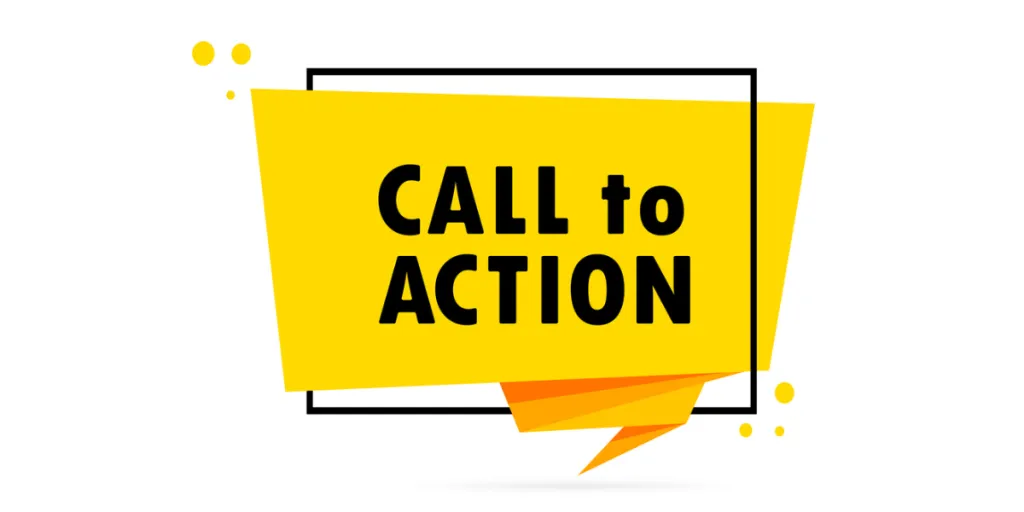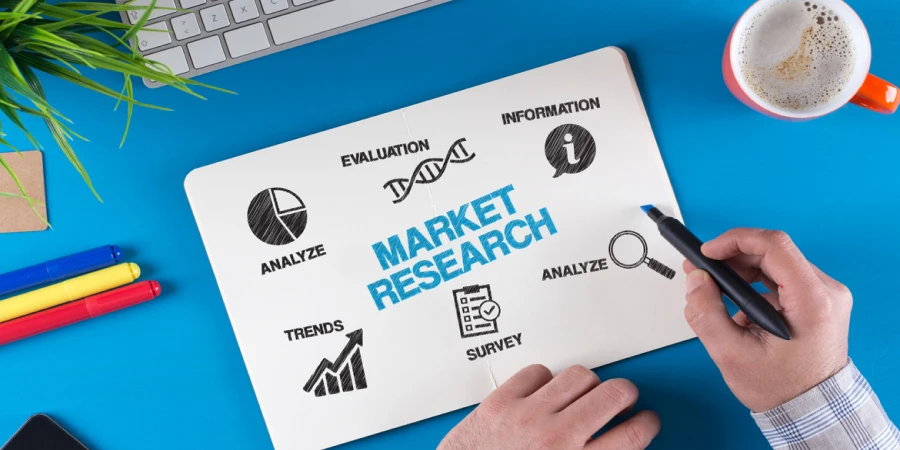Today, users are actively looking for a personalized customer experience. Targeted email marketing is a great way to respond to that need by ensuring that the messages those customers receive are always relevant.
In this article, we’re going to tackle everything you need to know to be successful in targeted email marketing. By the end, you’ll know how to create targeted emails that sound like they’re coming from a close friend rather than a company.
Let’s jump in:
● What is targeted email marketing?
● Benefits of targeted email marketing
● How to create a targeted email marketing campaign
● Targeted email marketing examples
What is targeted email marketing?
Targeted email marketing is sending specifically targeted email campaigns to subscribers based on their segmented characteristics, like profile data, behavior, location, etc. It leverages customer data and insights to personalize messages for each segment’s preferences and needs, leading to higher engagement and conversion rates.
By segmenting your subscribers and sending targeted email campaigns, you can craft a more relevant message for customers who fall into a certain segment. The more detailed your segments, the more relevant the message.
But why create a targeted email marketing campaign? Don’t the batch and blast methods work?
Benefits of targeted email marketing
In 2023, targeted email marketing, driven by behavior-based automated emails, generated 41% of all email orders, per our internal data. This was from just 2% of all email sends.
Clearly, targeted emails are critical in capturing user interest and encouraging recipients to take the desired actions.
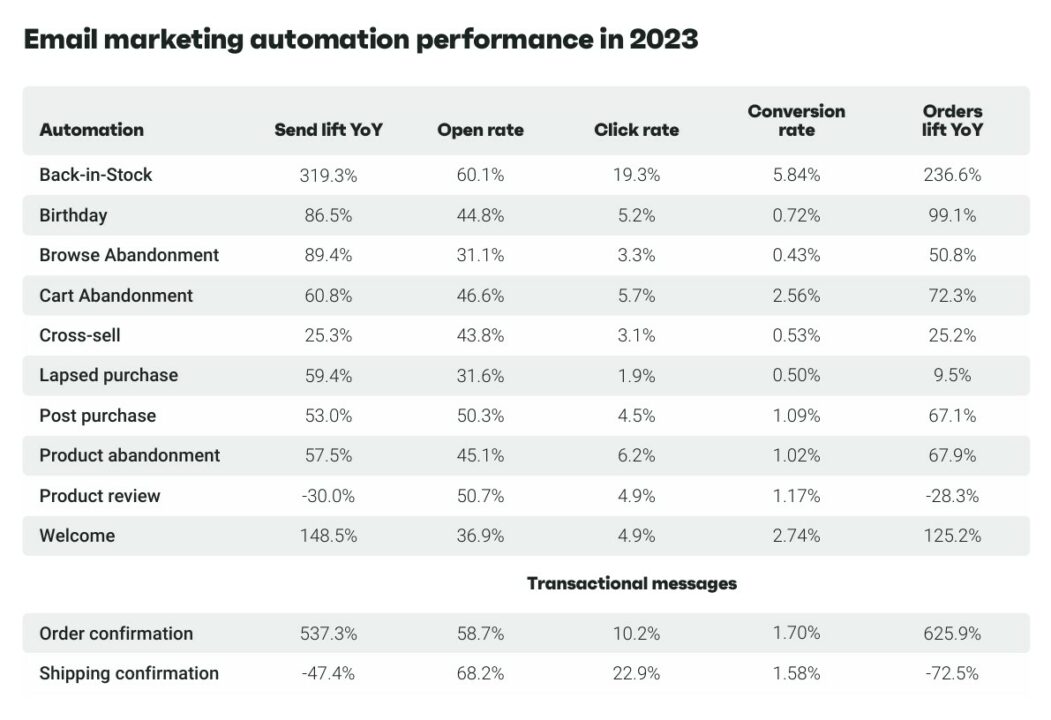
Generic messages are often ignored, while tailored content that aligns with individual preferences strengthens customer relationships. This approach not only leads to higher open rates and click-throughs but also drives conversions and, ultimately, increases the return on investment from your email marketing campaigns.
So, let’s sum this up:
- More relevant emails: Segmentation lets you create personalized content for specific audience groups, making it more relevant
- Increased customer engagement: Targeted emails resonate better with recipients, leading to higher open and click-through rates
- Improved ROI: Targeted campaigns drive more conversions, maximizing your email marketing return on investment
- Improved customer retention: Relevant messages keep subscribers interested, reducing churn and fostering long-term relationships
 | “Surprisingly, 51% of marketers simply aren’t segmenting their email lists. Many factors can influence this oversight — a misunderstanding of the channel, a resource issue, or just time constraints. Whatever the reason, it’s a critical missed opportunity. Email marketing remains a powerful tool, and segmentation is the key to unlocking its true potential.” — Rytis Lauris, Omnisend Co-founder and CEO |
We’re going to show you what you need to know to create an excellent targeted email marketing campaign to boost your email ROI.
How to create a targeted email marketing campaign
There are a few steps you’ll need to take when segmenting your subscribers for a targeted email campaign. If you already have a sizable list, this might take a bit of setup.
However, once you determine what your segments are, you’ll be able to auto-segment your contacts when you create targeted emails from this point on. Maintenance will be next to nothing.
Define what data you need
The first thing you need to do when creating a targeted email marketing campaign is to define the kinds of segments you need for your online store.
There are a lot of basic segments you’ll likely want to have, but they usually fall into a few different categories. For example, imagine you have an outdoor wear ecommerce store. Here’s how you could segment the email list:
| Segmentation category | Targeting criteria | Description |
| Customer profile data | – Age (20-30 years) – Gender (women) – Location (mountainous regions) | Offer specialized collections or discounts tailored to different demographics, such as women’s hiking shoes or discounts for customers in specific regions. |
| Interactions with previous email campaigns | Opened/not opened, clicked/not clicked, highly engaged, inactive, etc. | Target engaged subscribers with exclusive offers or rewards, and re-engage inactive subscribers with lucrative incentives or reminders. |
| Interactions with previous email campaigns | Customers who: – Have recently purchased – Have purchased once – Purchase regularly – Have abandoned their cart | Analyze shopping and browsing behavior. Recommend complementary products based on past purchases or browsing history, and send personalized offers to customers who have abandoned their carts. |
Being able to segment based on preferences means that you’re only showing the products your customer has the highest probability of being interested in.
So, think about the data that you need to target your email campaigns properly:
- Email address
- Name
- Age
- Gender
- Location
- Interests/preferences
Plus anything else that you think might be useful. Once you define the data you need, you can adjust your opt-in forms, surveys, and lead magnets to capture that information.
For a complete guide to email segmentation, check out our article here!
Connect your channels: CRM + email marketing platform + online store
A great way to unify the data across your store, CRM, and email platform is to connect the three.
You can start that by ensuring your chosen platforms offer integration capabilities. Then, use built-in integrations or APIs to sync customer data across platforms, enabling real-time updates and continuous data flow.
This is a great way to not only make sure your information is in the same place, but also to make sure that your information is updating on each of those platforms as your customers are acquired, retained, churned, and everything in between.
Create buyer’s personas based on those segments
Creating a marketing persona based on the data you use is critical for this next part. For each segment, you’ll need to create a separate buyer’s persona.
Why?
Because it’s easier to write when you know who you’re talking to. You wouldn’t talk to a woman in her 40s from Brooklyn the same way you’d talk to a 17-year-old guy from rural Missouri.
Below is the example of a buyer persona for an outdoor apparel brand:
Buyer persona
Amelia, 40
Demographics
Female, lives in Denver, Colorado, single. Works as a software engineer and earns $75,000 annually. Active lifestyle.
Goals and motivation
Wants to stay fit and healthy through outdoor activities like hiking, camping, and rock climbing. Desires high-quality, durable gear that can withstand harsh conditions. Seeks eco-friendly and sustainable products.
Pain points
Overwhelmed by the vast selection of outdoor gear available online. Concerned about sizing and fit when ordering clothing and shoes online. Wants detailed product descriptions and reviews.
Common objections
Doubts the authenticity and quality of some lesser-known brands sold online. Worries about lengthy shipping times and hassles with returns.
Interests
Follows influencers and blogs related to outdoor adventures, fitness, and environmentalism. Enjoys weekend getaways to national parks and scenic trails. Passionate about minimalism and sustainable living.
You want to know your customer, put a face and a name to them. So you create a buyer’s persona to achieve this. Let’s say you sell business casual fashion for women.
Your buyer’s persona should include vital information:
- Name (it doesn’t have to be your customer’s actual name, it’s a symbol)
- Job role (especially if you’re selling clothing or other things for work)
- Likes, dislikes, hobbies, interests
- Age, gender, location, revenue, family, etc
- What they want — ideally the problem you solve
- The message that your brand offers this customer
Obviously, you’re not necessarily going to have all of this data. It’s awesome if you do, but chances are, you won’t.
The idea is to create a representation or figurehead of your customer based on the data that you have on your customers, and how you fulfill their needs.
You’re likely to have more than one segment when creating targeted email campaigns. To make them work, you should have separate personas for each segment.
What you can also do is create a typical road map for each customer persona so you know how to communicate with that specific customer, no matter where they are in their purchase journey. This will also help you make your emails personalized for each customer.
Related:
Ecommerce personalization: A beginner’s guide [10+ examples]
Email personalization: Strategies, tips, and best practices
Create content specifically for those customers
Now that you’re armed with your handy customer personas, you can begin crafting the perfect email to each customer type.
Using your persona, write your email copy and headlines as if the person was sitting in the room with you:
- What would you say to that person?
- How can you help them get what they need?
- What kind of offer would interest them?
While this might seem abstract, let’s say you created a buyer’s persona of Brie, a businesswoman from Brooklyn who is in her 40s. Let’s also say you want to send her a targeted email for a holiday sale.
However, we’re past the point of shipping for Christmas — so she’s likely not shopping online for last-minute gifts. But chances are, she’s probably got a New Years’ party to go to, and you still have time to get a swanky dress out to her.
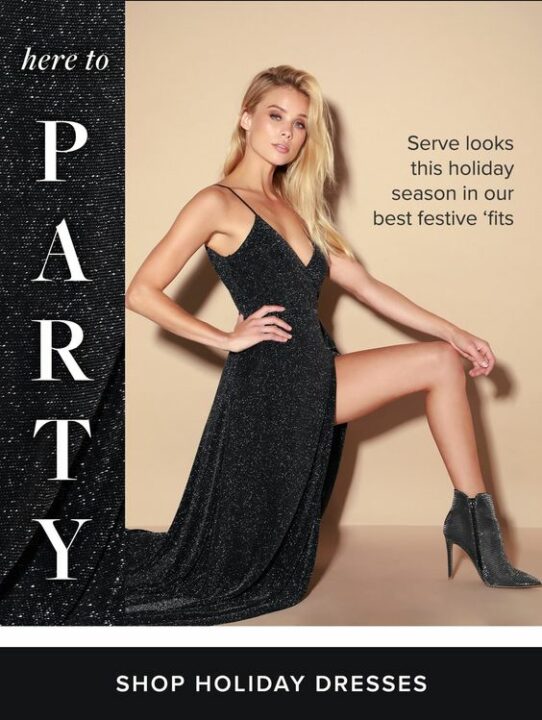
See, Brie needs a nice new party dress — and thanks to the products she searches for and her purchase history with you, you know she likes to keep it classy. Showing more formal party dresses to her will be much more relevant.
After all, she just spent all that money on Christmas gifts. She should treat herself! A discount will give her even more incentive to do so.
Obviously, you wouldn’t target this campaign towards the younger female customers. This might be too sophisticated, and they have less disposable income. So using your persona created for your younger segments, you would create content specifically for them.
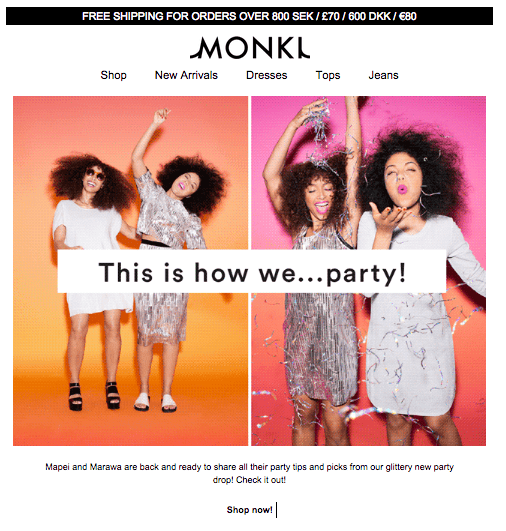
It goes without saying that this idea of creating content specifically for each segment also translates well to your PPC and social media campaigns.
Learn more about crafting the perfect email subject line with our 105 email subject lines for all occasions!
Choose a great email marketing platform
Email is powerful on its own, but if you’re looking to create the best targeted email marketing campaigns, go with a platform that offers smart segmentation.
You ideally want a targeted email marketing service that:
- Offers precise segmentation of your contacts based on
- Profile data
- Shopping behavior
- Campaign behavior
- Provides popups and landing pages for email capture
- Allows you to connect more marketing channels
- Integrates with your store for easy product recommendations
A great email marketing tool lets you segment your contacts into groups of customer personas, based on the available data.
Segmenting by shopping behavior is crucial as it allows you to create precise content based on the customer journey. For instance, you can showcase products left behind by customers in their carts and provide recommendations using abandoned cart emails.
A robust email tool enables auto-segmentation of contacts when a lead is captured, ensuring tailored messaging based on the source (product page, blog, or lead magnet).
Ideally, the platform would also harness the power of omnichannel marketing by connecting various channels, unifying data collection and the customer experience.
Considering all of that, it’s worth investing in the best email marketing software and reap the benefits of segmenting.
There’s also built-in Facebook and Google audience sync and the option to create omnichannel campaigns combining email, SMS, and web push notifications.
The best part? An impressive 4.8 star rating on Shopify, with over 5.1K 5-star reviews, and 4.6 stars on G2. You can’t go wrong with this app.
👉 Need more info first? Learn more about the Omnisend email app
⭐️⭐️⭐️⭐️⭐️
“We’ve been able to segment our customers into even greater detail than we ever have before and have developed new targeted mail campaigns as well as super specific cross-selling targeted marketing campaigns.”
— Victoria H., Omnisend user, G2 review
Regardless of which email marketing platform you choose, ensuring it has these basics will make your targeted ecommerce marketing campaigns much smoother.
Measure and test your targeted email marketing campaign
So once you follow all of these tips, you’re done and your emails will be amazing forever right?
Wrong.
The fact is, when you’re using targeted email marketing, you’re never done.
Your customers won’t be the same forever, and your messages might get stale after a while, especially if you don’t change it up every now and then.
Aside from that, you should be reacting to the data from your campaigns. If you have customers that stop engaging, figure out why they’ve stopped with some A/B testing. You should be A/B testing regularly with your promos, your subject lines, and various other elements around your campaigns.
You have tons of data — use it to your advantage to achieve the best results. Also, you can find a lot of useful resources to deepen your knowledge like blog articles or email marketing courses.
Targeted email marketing examples
To help you get started with segmentation and personalization of your emails, we’ve compiled a list of great targeted email marketing examples.
1. Abandoned cart reminder emails
Abandoned cart emails are used for re-engaging customers who’ve shown interest in your products but didn’t complete their purchase. By targeting these potential buyers with timely and personalized reminders, you can recover lost sales and boost conversions.
Take To’ak Chocolate’s success story, for example. Through targeted email marketing, the premium chocolate brand has seen remarkable results — a 43.9% open rate, an impressive 44% conversion rate, and $3.64 revenue per email.
In the email below, they show the delicious Caramelized Pop Amaranth the recipient left behind, along with a tempting description. A prominent “View Product” button entices the prospect to finalize the purchase.
In case the prospect is indecisive, they’ve even included a link to their tasting guide, making it a breeze to explore other decadent options.
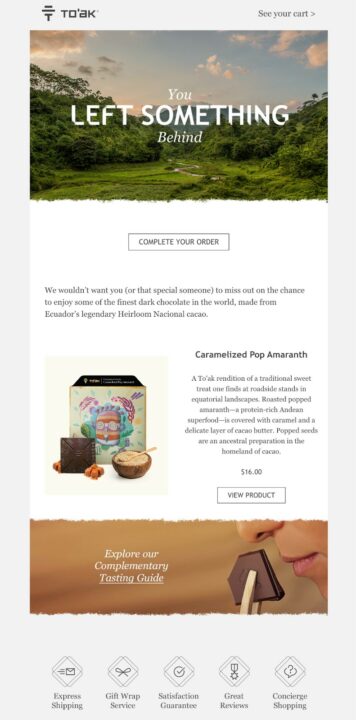
Also consider:
7 best practices for nailing your abandoned cart emails
2. Product abandonment emails
Targeting customers who’ve shown interest in specific products but haven’t added them to their cart is another powerful email marketing tactic. By reminding them of the items they viewed, you can reignite their interest and guide them towards a purchase.
With a 13% conversion rate for their product abandonment emails, B-Wear’s success story highlights what brands can achieve by utilizing such practice.
 | “All of our automated emails have proven to be beneficial… Once you set them up and let them run, we’re generating income from them with minimal effort.” — Jason Slattery, Marketing Manager, B-Wear |
In their “Still shopping? Pick up where you left off!” email, B-Wear showcases the abandoned product — a long-sleeve premium tee — with a prominent “Shop Now” CTA button.
They also include links to their latest collections and add a slogan “Shop now. Pay later. Always interest-free!”, making their offers hard to resist.
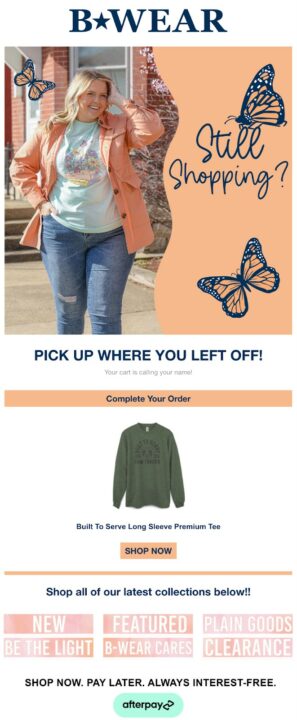
3. Welcome emails
Sending welcome emails to new subscribers helps you make a memorable first impression. While you want to engage new subscribers right from the start, this tactic isn’t just about greetings. It’s about opening a dialogue that feels exclusive and direct to foster loyalty and drive conversions.
Consider Island Olive Oil Company’s success story. Their welcome emails drive a staggering 998% higher click rate than standard promotional emails. This has led to an average 11% conversion rate and a revenue-per-email increase of 3,274%, far surpassing traditional campaigns.
 | “Welcome series helps to separate a small business like us from buying it on Amazon. No offence to Amazon, but it helps us to be boutique in the big world of the internet.” — Angèl Foster, Co-Owner of Island Olive Oil Company |
Their “Aloha Foodie Friend!” email warmly greets new subscribers. It offers a time-limited 10% discount to prompt quick action, along with the promise of exclusive offers and recipes.
Subscribers also get a sneak peek into Island Olive Oil’s world through an engaging “A Little Bit About Us” video.

Related:
- How to create a welcome email template + examples
- 10 best welcome email examples for 2024 [+ templates & tips]
- Welcome series: A detailed how-to guide with examples
4. Seasonal promotions
Seasonal campaigns are a powerful way to tap into consumer trends. They leverage the excitement of holidays or special occasions to engage customers while creating a sense of urgency to shop for your products. By targeting customers with time-limited, relevant offers, you can drive significant sales during peak periods.
Outdoor gear retailer Amundsen Sports’s success story is a testament to this. The business attributes a significant 70.6% of its annual sales to promotional campaigns.
In the example below, Amundsen’s “Holiday Gift Guide” email features a thoughtful selection of jackets, marvins, and heavy pullnecks presented in an inviting grid layout.
Accompanied by the “Spirit of Adventure” narrative, it stirs interest in recipients, nudging them towards the Men’s and Women’s gift guides. Additionally, the inclusion of trust signals like “Made in Europe” and “Field Tested” reinforces brand credibility.
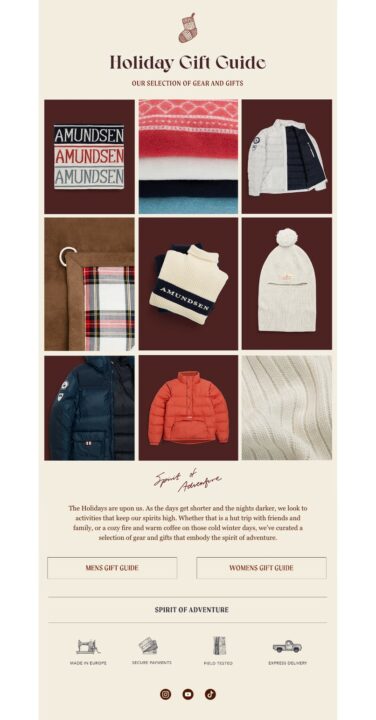
Related:
10+ effective email marketing examples [inspiration + tips]
5. Win-back emails
Targeting inactive or lost customers with win-back emails can help re-engage them and reignite their interest in your brand.
By offering exclusive incentives with personalized messaging, you tap into the customer’s psyche, subtly reminding them of the unique value your service provides and ensuring your brand remains at the forefront of their mind.Even a small nudge can make a big difference.
Equestrian apparel brand Kerrits’ success story is a good example. Their automated messages, including win-back efforts, account for 23% of email sales — even though they comprise less than 4% of sends.
In the win-back email example below, Kerrits cleverly leverages a seasonal hook (International Carrot Day) to offer an extra 20% off clearance items.
In addition to “Shop Clearance” CTA, the email also features CTAs for Women’s and Kids Sales. Lastly, a user-generated content section encourages social engagement, fostering a sense of community.
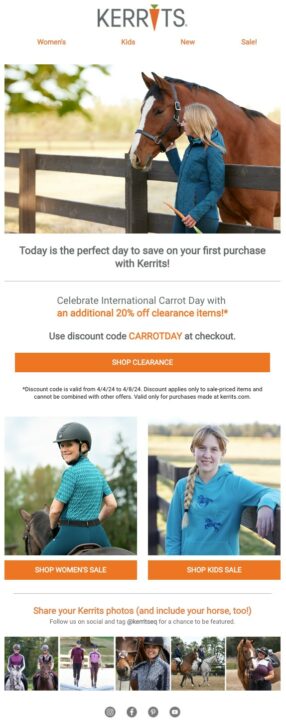
Related:
Win-back emails that convert like crazy (+examples)
Wrapping up
Targeted email marketing can be challenging without the right strategies. However, by prioritizing the customer in your marketing approach, regardless of the channel, you can make this process much easier. With this focus, gathering data and tailoring your campaigns to each customer becomes second nature. And at that point you’ll reap the benefits of targeted email marketing.
Source from Omnisend
Disclaimer: The information set forth above is provided by omnisend.com independently of Alibaba.com. Alibaba.com makes no representation and warranties as to the quality and reliability of the seller and products.

